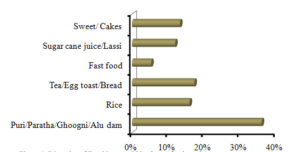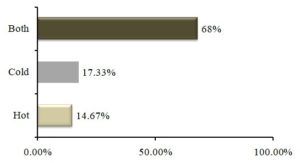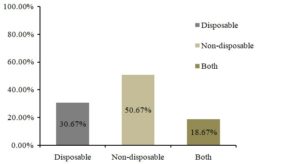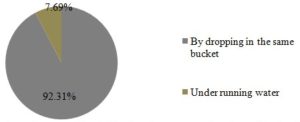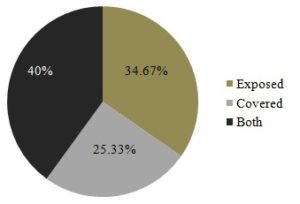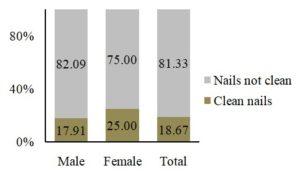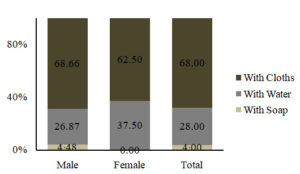ISSN: 0973-7510
E-ISSN: 2581-690X
The safety of street food is an important aspect in the field of nutrition security. A cross sectional study was conducted among street food vendors around the medical colleges of Kolkata selected by simple random sampling. Data were collected by interviewing the selected food vendors with the predesigned schedule and observation. Microbiological analyses of food samples selected randomly from seventy five vendors were carried out. Food vendors unwilling or abstaining from the interview could not be selected in this current study. None of the food vendors used head cap or apron or hand gloves during preparation or selling of foods. Only 25.33% of food vendors covered the foods after preparation. Most of the vendors were cleaning their serving utensils in stagnant water of bucket. The continuous re-use of same stagnant water for washing non-disposable utensils led to deposition of food materials on them and this increased the chance of chemical and microbial contamination as well as enhanced the food borne intoxication. Half of the food samples were contaminated with the organisms causing Food Borne Diseases. Significant relationship was found between various hygienic practices and presence of probable food borne pathogenic bacteria. Approximately 81% of the food vendors did not have clean nails and nor did they use gloves for food service resulting in increased chances of microbial contamination in the foods. Also, the amount of food vendors using the leftover food of previous day was 44% meaning a significant decrease in food quality due to mixing of leftover foods. So, the hygienic practices of the food vendors around the medical colleges of Kolkata were very poor and foods served were contaminated.
Street Foods, Street Food Vendors, Food Safety, Hygienic Practices, Food Borne Diseases
The Food and Agriculture Organization of United Nations (FAO) defines Street foods as ready–to-eat foods and beverages prepared and/or sold by vendors and hawkers, especially in streets and other public places. Street food retailing is wide spread in urban areas of developing countries.1 It provides cost effective source of nourishment especially for the low-income workers of the urban poor populations.2,3 According to a 2007 study from the FAO, 2.5 billion people eat street food every day all over the world. Since it is obvious that proper hygienic quality of street vended foods is questionable, these may lead to food borne diseases which remain a major public health concern globally especially in case of diarrheal diseases. So, the safety of street foods is the most important aspect in the field of nutrition security. Ensuring food safety has been recognized as an important component in protecting the health of the people.4
According to National Policy for Urban Street Vendor/Hawker, in India, street food vendors constitute approximately 2% of the population of a metropolis.5 Street foods are conceived as major public health concern since there is lack of infrastructure in assessing and monitoring large number of street food vendors due to their mobility, miscellany and transitory nature.6,7
The eating habits of a considerable number of people in Kolkata have changed like many metropolises due to increase in city’s labour force and other mandatory aspects. Street foods area adopted chiefly because they are inexpensive, the taste is acceptable and they are conveniently available wherever people are gathered purposefully(schools, marketplaces, railway stations and office centers’). In Sealdah area, Kolkata, 1 to 2 % of the consumers spent between Rs. 1,500 to Rs.2,000 per month on street foods. On an average, regular consumers spent Rs. 750 on street foods per month.
Most of the studies done on street foods in India and abroad had indicated that these foods were not meeting the recommended microbiological standards and were contaminated with various pathogens viz. E. coli, Vibrio cholerae, Salmonellae, Listeria sp., etc. bringing mortality worldwide.8 The microbiological status of the food has been reported to be dependent on several factors like quality of raw material; handling and processing of food, microorganisms those survive the preservation and storage treatment, post process contamination.9 The recent cases of food poisoning in Kottayam district of the state of Kerala and very recent street food poisoning incident in Koderma district of Jharkhand emphasize the poor knowledge of food safety, hygiene and microbiological quality of the foods served. Also, the food poisoning case in a religious gathering in Maharastra may be considered as an example of lack of concept of proper food hygiene amongst common people.10 There is a gross lack of awareness of epidemiological significance of street foods and no concept of food hygiene and safety measures along with very little public awareness about the safety of foods vended in streets. Earlier epidemiological studies suggest that, this poor knowledge about street food safety and host-pathogen relationship could lead to cases of food poisoning. There had been incidences of food poisoning outbreaks from street foods in Shangdong province (China) where 691 outbreaks were recorded along with 49 deaths during the span of 1983 to 1992.11 Besides direct health consequences, these food borne illnesses can reduce the productivity and economic output, and also impose substantial stress on health care system.12,13 Identification of precise sources of microbial contamination is crucial when devising strategies to reduce further outbreaks.
A cross sectional study was conducted among the street food vendors around the medical colleges of Kolkata who sold ready to eat foods especially in the street or market or any public place.
The duration of the study was two months from January 2020 to February 2020, since this period of the year becomes dry with lesser amount of moisture in the environment and chances of microbial contamination gets decreased. The aim of the study was to check the hygienic condition especially in the microbiological context at the time where chances of contaminations become lower due to environmental factors.
Taking prevalence (p) = 23; as indicated in an earlier similar study conducted in Kenya by Muhonja and Kimathi14 and absolute error as 10%, the sample size was determined by using the formula n = (1.96)2pq/L2 and it was 68. [Prevalence (p) =23%, q= (100-p) = 77%; L= estimate of precision, here taken as 10%.]By considering the non-response cases as 10% of the total sample; the revised sample size was 75.
There are seven medical colleges in Kolkata. The total number of food vendors around (within 50 metres radius) all medical colleges were listed and 75 food vendors were selected by simple random sampling.
There were two parts of this study- first; assessing the hygienic practices of the street food vendors and the microbiological analyses of selected food samples to check the food safety. Assessment of hygienic practices was done among 75 randomly selected food vendors and food samples for microbiological analysis were collected from 30% of food vendors selected by simple random sampling as similarity of food vending operations and poor hygienic conditions along with concept of food safety were observed amongst various food vendors examined. The gross activity of mesophilic bacteria usually stays low during the winter season in January and February at Kolkata. The study aimed to determine the microbiological standard of street foods even in that weather condition when chances bacterial contamination usually keeps low.
Data collection
Data collection was done in two ways- direct observation and interview with predesigned, pretested schedule. Confidentiality of the responses was assured. The data were collected specially on demography, sources of water, display of food items, types of serving plates, mode of washing plates, management of left-overs and personal hygiene.
Food sample collection procedure
Food sample collection for bacterial analysis was performed during the month of January and February, 2020. The average outside temperature during that period was 26°C. The microbiological studies were conducted during the end of February and beginning of March, 2020. Generally, the food samples were taken at the time of lunch. The foods of interest were purchased from the street vendors as it is for self-consumption. After the collection food samples were carried to the laboratory in pre-sterilized, labeled containers. The collected food samples were brought to the laboratory as soon as possible and kept in refrigerator but not for more than 36 hours.
Microbiological analyses
For microbiological analyses detection of E.coli, Staphylococcus sp., Shigella sp. and Enterobacter sp. were emphasised since these are well known for water and food borne contaminations.15 Briefly, food samples were weighed at first and then pH of the foods were measured. Each sample was thoroughly mixed with calculated volume of sterile distilled water. Serial dilutions of samples were prepared for further analysis. After serial dilution, the diluted samples were transferred to the Nutrient Agar plates, and incubated at 37°C for overnight. After incubation the numbers of colonies were counted on the plates. The isolated colonies of microorganisms were transferred to fresh Nutrient agar plate for maintenance and further characterisation. For the identification of bacteria, the isolated colonies were morphologically characterized, e.g. colonial growth and pigmentation. The bacterial isolates were primarily characterized by Gram staining procedure using compound light microscope with oil-immersion objective. The different media used for this microbiological analysis were EMBagar, MacConkey agar. In biochemical characterization, Catalase test, IMViC test, Starch hydrolysis, Carbohydrate fermentation (lactose, sucrose, dextrose) was also performed. Presence of Lactic acid bacteria in curd related foods were analysed by using MRS medium in an aerobic condition.
Statistical analyses
Correlation between presence of food borne pathogens and various hygienic factors were assessed by logistic regression analysis using ‘R’.
Out of the 75 street food vendors interviewed, 89.33% were male and 10.67% were female. Majority of the food vendors (56.00%) belonged to 40-60 years’ age group followed by 41.33% in the age group of 20-30 years.
36% of the study population was selling puri/paratha/muri/ghoogni/daal/alurdam. 12% vendors sold sugar cane juice/lassi. 16% of them sold Rice, 17.33% sold tea, biscuits, bread/eggtoast, and 5.33% sold fast-foods and remaining were selling other things like sweets, cake, etc. (Figure 1).
All the food vendors used tap water for drinking. 73 vendors out of 75 were using tap water for cooking and remaining two were not using water for cooking because they sold ready-to-eat packaged food (Table 1). Tap water was used for was hing plates by 100% of the food vendors who were not using disposable plates.
Table (1):
Overall hygienic practices of the food vendors (n=75)
| Attributes | Frequency | Percentage | |
|---|---|---|---|
| Nature of foods | Hot | 11 | 14.67 |
| Cold | 13 | 17.33 | |
| Both | 51 | 68.00 | |
| Types of plates for servings foods | Disposable | 23 | 30.67 |
| Non-disposable | 38 | 50.67 | |
| Both | 14 | 18.67 | |
| Process of cleaning of serving plates (n=52) | By dropping in same buckets | 48 | 92.31 |
| Under running water | 4 | 7.69 | |
| Presentation of food items | Exposed | 26 | 34.67 |
| Covered | 19 | 25.33 | |
| Both | 30 | 40.00 | |
| Management of left-overs | No left over | 32 | 42.67 |
| Used on next days | 33 | 44.00 | |
| Eat at home | 9 | 12.00 | |
| Thrown away | 1 | 1.33 | |
| Fly Nuisance | Yes | 35 | 46.67 |
| No | 40 | 53.33 | |
| Cleaning of hands | With cloths | 51 | 68.00 |
| With water | 21 | 28.00 | |
| With soaps | 3 | 4.00 | |
| Water source for cooking | Tap water | 73 | 97.33 |
| No water (sold ready-to-eat foods) | 2 | — | |
Most of the food vendors (88%) carried water by drums from the water sources to their business premises. 8% used bottles and 4% bucket for this purpose. Muindeand Kuria’s study found water was ferried from homes of the street food vendors because no potable water was available at their areas of operation.16 They reported that 86% food vendors in their survey were using tap water. This mainly depends upon the socio economic status of the vendor as well as the family. This also concurred with the study conducted by Bryan et al. and Abdalla et.al.8,17 Water may be a source of E. coli, Campylobacter sp. and previous studies have indicated the scarcity of potable water at many regions of Asia, Africa, South America to be used by street food vendors for various purposes.18 Indian studies have also shown the presence of low potability of water with respect to microbiological standards used for drinking and dish washing 19,20 at street food vending stalls which is similar for most of the cases observed in this study too.
96% of the vendors were selling food on road. Twelve out of seventy five, sold food near open drains and seven vendors sold food near garbage. So, there was a high chance of contamination of food with dust, vehicle exhausts, pathogenic microorganisms etc. So it was evident that, usually food vending conditions for several vendors were unsuitable and this type of scenario was reported earlier also relating to food borne diseases.19,21 It was observed in this study that, in many cases the same vending place is utilized by several vendors sequentially promoting chances of cross-contaminations.
14.67% of vendors served hot foods and 17.33% served cold foods (Figure 2). Selling of hot foods may decrease the chances of microbial contamination but heating and cooling down a food item in repeated cycles may also decrease the quality of food considerably.22 The cold or ambient temperature foods may have great chance of microbial contamination along with other types of contaminations. Inadequate reheating of stored foods during the busy periods with high demands and obviously to save fuel as observed in this case, may also become a cause for bacterial development in the food. Similar observations contributing to increase in microbial load in such street foods were reported earlier too.23
Figure 3. Street food vendors according to use of different types of plates for serving foods (n=75)
Among vendors using non-disposable (Figure 3) plates 92.31% were cleaning their serving utensils in stagnant water of bucket (Figure 4); (Table 1). Comfort O. Chukuezi found that the 47.62% of the vendors washed their utensils with dirty water which was recycled.24 Properly cleaned utensils and cooking as well as food vending equipments are required for maintenance of food safety. The status of utensils observed in this study was not satisfactory with respect to sanitary and hygienic standards as poorly cleaned utensils in stagnant water may contain residual food items and can facilitate microbial growth as well as generation of bacterial exotoxins and needless to say cross-contamination similar to some previous studies.11
For the protection of foods from microorganism, dust, flies it is desirable to keep the foods covered. 34.67% of the food vendors kept food open and 25.33% covered the foods (Figure 5). 40% of the vendors kept some foods open and some covered (Table 1).
42.67% of the food vendors usually had no leftovers. A good percentage (44%) of vendors kept the left-overs for the next day use, 1.33% threw away the left-overs and 12% took the leftovers at home. As a very high percentage of food vendors served their leftover in next day, the freshness of foods was not there and quality was compromised. Comfort O. Chukuezi also found same kind of results where 42.86% had leftovers for serving the next day with poor storage facilities. The reason behind this may be due to poor socio-economic status and to reduce the cost they used the leftovers on the next day. This concurred with the study of Muinde & Kuria which revealed that 35% of the vendors had left-over.16 Out of those, 32.1% reported consuming them and the rest stored them for the following day’s sale. Consumption of left-over food on next day may impose the chances of contamination and degradation of food quality as a whole but these points were not seemed to be considered by the food vendors. Storage of unsold foods for next day or next round of business was obvious amongst the street food vendors here but usually storage conditions were improper leading to high microbial growth of diverse types. This practice of storing left-over foods was also identified in previous studies and significant microbial load was reported in Pakistan.25-27 The hot and humid weather of Kolkata city almost round the year also supports this type of microbial development on the left-over foods. A study based on Chandigarh reported about the marked increase of microbial load on storage for 16-24 hrs and principal bacterial types identified were Salmonellae, Shigellae, Pseudomonas etc. as enteric pathogens.11 A recent study carried out in Lucknow, UP also speculated about the chances of contamination by faecal food borne pathogens due to the filthy conditions of street food vending both in the personal as well as community hygiene aspects and regarded the street food mostly as unhygienic.28
Personal hygiene is an important aspect to everybody and it is very essential for food vendors because poor personal hygiene increase the contamination greatly. In this study, none of the food vendors used head cap or apron or hand gloves during preparation or selling of foods indicating lack of proper personal hygiene. Previous studies have shown that, use of aprons, gloves or head cap during serving the food items was practiced by only small proportion of the food vendors and this practice of not following the use of gloves or head cap or aprons led to less safety of street,24 since they found that 42.86% did not use aprons; 47.62% handled food with bare hands and 52.38% wore no hair covering while 61.90% handled money while serving food. Hygienic practices of street food vending of densely populated cities were also found to be similar as demonstrated in a previous study in China where low financial condition of the vendors was identified as a potential cause of ill hygiene of street foods.29
Only 20% of food vendors wore clean clothes and remaining (80%) wore unclean clothes. 82.09% of the male food vendors wore clean clothes. On the other hands 62.50% of female food vendors wore clean clothes. Wearing of metallic jewellaries during food handling may not be considered as hygienic since food materials may get deposited on the jewellaries and stick to those leading to increased chance of microbial contaminations and biochemical reactions occurring on the metallic jewellaries due to microbial growth can lead to chemical poisoning and this was also observed previously.24
The nails of the maximum number of food vendors were not clean and they were handling the food without gloves. 82.09% of the males and 75% of females and in total 81.33% of food vendors did not have clean nail. 17.91% of males and 25% of females and in total 18.67% of the vendors possessed cleannails (Figure 6). Handling of foods in unsanitary ways such as using dirty hands, unclean nails, use of old and dirty aprons, gloves are considered as sources of contaminations as reported in a few studies.18
It is necessary aspect of personal hygiene to wash the hands properly before handling the food items to minimise the possibility of contamination of foods. But as shown in the study found that most of the food vendors cleaning hands with filthy clothes and very few of them washed their hands by soap before preparation of foods (Figure 7). The female street food vendors were found to be little bit more hygienic as compared to male food vendors. The personal hygiene and properly maintained food vending stalls in relation to street food safety was a concern as depicted in South Africa too where almost 76% of the street food vendors had very little knowledge about food safety and consequently led to poor sanitary quality of street foods.30
46.67% of the food vendors had fly nuisance (Table 1) and this might come out to be a serious problem in terms of hygienic quality of the foods. Since flies may bring about serious concerns in the hygienic condition of the food by contaminating the foods with many dirty materials like sewage and faecal matters. This also increases the chance of contaminating the food materials with probable food borne pathogens. In this study, it was observed that fly nuisance had significant relation with the presence of probable food borne pathogens (Table 2).
Table (2):
Relation between hygienic practices and presence of food borne pathogens
Attributes |
R2 value |
|---|---|
Vendors used clean clothes |
1.27# |
Mode of hand cleaning (soap/only water/only a cloth) |
2.069** |
Vendors used left-over foods on next day |
1.761** |
Fly nuisance present in the food |
2.954** |
**indicates p<0.05 & # indicates p>0.05
The bacterial load in sugar cane juice, fruit juice, chhatu-sarbat was relatively higher as they were not served as a hot food and compared to the other food items; the water content of these foods is high too. The bacterial load of Rosogolla was less which might be due to presence of sugar into it where sugar acted as a natural preservative.
Total bacterial count in rosogolla (solid food category) and lassi (liquid food items) were small compared to the other food items. The total bacterial count in the food items assayed is depicted in the Table 3.
Table (3):
Average total bacterial count in various food items
FoodItems |
Average ln CFU/ml or ln CFU/g ± SD |
|---|---|
Ghooghny |
15.570 ±0.75 |
Bread |
17.296 ±0.87 |
EggToast |
15.229 ±0.56 |
Rosogolla |
11.775 ±0.65 |
SugarCaneJuice |
17.182 ±0.84 |
ChhatuSarbat |
16.639 ±1.05 |
Lassi |
9.210 ±0.43 |
FruitJuice |
16.643 ±1.03 |
Half of the food samples were contaminated with organisms which may cause food borne diseases. Shigella sp., Staphylococcus sp., E.coli, were present in lassi, chhatu-sarbat, sugar cane juice, rosogolla, egg toast, bread and ghooghny of those 24 food samples (Table 4) which may cause serious food poisoning. Coli forms were found in 8.33% of the food samples. The presence of E.coli in food is chiefly an indicator of faecal contamination, concluding that those food samples might be faecally contaminated. Previous studies have also reported about the presence of E.coli in almost half of the samples assayed. The total bacterial load depicted here is a serious problem form the consumer point of view, since the numbers of users of these foods are very high, complicating the problems more. FSSAI also do not give any such concrete guideline about the permissive microbial load in respect of these types of foods.31
Table (4):
Selected bacterial types in food samples tested
| No. | Food Items | Avg. pH | Probable bacterial types | |||
|---|---|---|---|---|---|---|
| E. coli | Staphylococcus sp. | Shigella sp. | Enterobacter sp. | |||
| 1. | Ghooghny | 5.22 | + | + | – | + |
| 2. | Bread | 5.20 | + | + | + | – |
| 3. | Egg Toast | 6.30 | – | – | + | + |
| 4. | Rosogolla | 5.40 | – | – | – | + |
|
5. |
Sugar Cane Juice |
3.90 |
– |
+ |
– |
+ |
| 6. | Chatu Sarbat | 5.80 | – | – | + | – |
| 7. | Lassi | 4.35 | – | + | + | – |
| 8. | Fruit Juice | 3.20 | – | – | – | + |
The correlation between presence of food borne pathogens and various hygienic practices was studied. In this aspect, it was observed that, except the clothes worn by the food vendors, other hygienic attributes played significant roles in inducing probable food borne pathogens in the foods. Hygienic factors like mode of hand cleaning (soap/only water/only a piece of cloth), leftover foods and presence of flies in the foods contributed significantly in introducing food borne pathogens (Table 2).
The current study illustrates general practices of street food vendors around medical college and hospitals of Kolkata city. Since street foods are basically served with bare hands and the hands as well as fingers, nails are the most common ways to spread contaminations from other parts of the body like nose, lips, mouth, legs and faeces too, the hygienic quality is of utmost importance which is also in accordance with the data published by WHO.31 Here we have observed that, hygienic condition of the hands is very poor amongst most of the studied street food vendors which increased the chance of contamination by organisms like E. coli, Listeriae, Salmonellae etc.31,32 Also, the supply of clean water for washing hands and utensils maintaining the proper hygienic standard according to microbial and other aspects is not available at all the places in the city enhancing the chance of contracting microbial contaminants.8
Selection of food vending sites as the places around busy medical colleges is also impactful as major hospitals are associated with medical colleges and people are bound to avail the facilities available at medical colleges and associated hospitals as per medical emergency.
Analysis of hazards and probable microbial threats
Since several attributes of street food vendors like type and quality of water, utensils used, locations of the vending stalls, serving hot/cold/reheated foods were thoroughly studied, a potential hazard and probable microbiological threat analysis is predicted (Table 5) following the review work by S. Rane.11
Table (5):
Relation between food vending strategy with potential hazard and probable microbiological threats
| Attributes | Potential Hazard | Probable microbiological threat |
|---|---|---|
| Water and raw materials used (Principally tap water was used and washing of non-disposable plates in same water for several times) | Inappropriate waste disposal | Transmission of enteric pathogens like faecal E.coli, Salmonella enterica, Shigellasp, faecal Streptococci, Vibrio cholerae etc. |
| Vegetables and raw food materials | Probability of passage of spore formers like Bacillus, Clostridium, food borne Listeriae etc. | |
| Utensils & other equipment’s | Chemical contamination and severe Environmental pollution | Leaching of chemicals from the utensils due to repeated cycles of heating and serving foods without considering the quality of the utensils. Most importantly, damage to the environment due to improper disposal of non-degradable plastic and other polymeric food plates. |
| Food storage & reheating | Improper storage condition of foods and reheating | This may lead to growth and multiplication of food borne intoxicants like Clostridium botulinum and Staphylococcus aureus which can lay the potent and moderately heat stable bacterial toxins in the foods. |
| Personal Hygiene (Mostly dirty clothes and aprons used) | Bacterial & parasitic hazards | Unclean nails and unhygienic & dirty cloths may lead to contamination by Staphylococci, Entamoeba and helminths |
| Food vending location (Near garbage and open sewages) | Indecent food handling | Dirty and unhygienic locations as near to garbage or open sewage passage may lead to cross-contamination involving microbes facilitating faecal-oral routes and also vector-borne diseases due to fly nuisance. |
The hygienic practices of the food vendors around the medical colleges of Kolkata were very poor. Majority of the vendors did not maintain proper personal hygiene. Foods were not safe as half of the food samples were contaminated with the bacteria, both fecal and non-fecal, that can cause food borne diseases. This might be due to lack of proper knowledge regarding food hygiene. Another thing that has to be considered in respect of street food vending in Kolkata city is that the financial condition of the food vendors is usually poor and they look for the profit as high as possible with their least possible investment.
Therefore, education of the food vendors about personal hygiene becomes necessary and trainings should therefore, be arranged for the street food vendors on various aspects of personal hygiene. The state may think about conducting such workshops, training programmes involving NSS from different educational institutions. The FSSAI should also think to frame some baseline about the permissive microbial load in these foods readily sold in the streets.
Future scope
This type of studies on larger scale may be undertaken in future by the people in National Service Scheme from many educational institutions. This would help gather the knowledge of food safety, personal hygiene for food handling and spread the concept of nutrition security with respect to potable standard of foods amongst the street food vendors of developing countries contributing to nation development. Also FSSAI may impose guidelines to increase the hygienic quality of street foods depending on the results of this type of further studies.
ACKNOWLEDGMENTS
The author is grateful to Sri Malay Mitra, AIIH&PH, Kolkata for helping in the collection of data. The author sincerely acknowledges The Principal & Head of Microbiology Department, Maulana Azad College Kolkata for allowing to conduct the study by using the laboratory facility. The author is also grateful to the Department of Higher Education, Govt. of West Bengal for the financial resources.
FUNDING
None.
DATA AVAILABILITY
All datasets generated or analyzed during this study are included in the manuscript.
ETHICS STATEMENT
Not applicable.
- Solomons NW, Gross R. Urban Nutrition in Developing Countries. Nutr Rev. 1995;53(4):90-95.
Crossref - Kaferstein F, Abdussalam M. Food Safety in the 21st Century, 77; 1999. Accessed September 21, 2023. https://www.ncbi.nlm.nih.gov/pmc/articles/PMC2557642/pdf/10327714.pdf
- Freese E, Romero-Abal ME, Solomons NW, Gross R. The microbiological safety of typical Guatemalan foods from street vendors, low-income homes and hotels. Int J Food Sci Nutr. 1998;49(1):27-38.
Crossref - The Prevention ofFood Adulteration Act & Rules, Govt. of India(as on 1.10.2004).; 2004. Accessed September 21, 2023. https://fssai.gov.in/upload/uploadfiles/files/pfa-acts-and-rules.pdf
- Bhowmik SK. Street Vendors in Asia/ : A Review Growth of Street Vending. Econ Polit Wkly. 2005:2256-2264.
- Ghosh M, Wahi S, Kumar M, Ganguli A. Prevalence of enterotoxigenic Staphylococcus aureus and Shigella spp. in some raw street vended Indian foods. Int J Environ Health Res. 2007;17(2):151-156.
Crossref - De Sousa CP. The Impact of Food Manufacturing Practices on Food borne Diseases. Braz arch Bioltechnol. 2008;51(4):815-823.
Crossref - Bryan FL, Michanie SC, Alvarez P, Paniagua A. Critical Control Points of Street-Vended Foods in the Dominican Republic. J Food Prot. 1988;51(5):373-383.
Crossref - Jones RN. Microbiological Conclusions. Drugs. 1991;42(Suppl 3):22-24.doi: 10.2165/00003495-199100423-00006
- Bajaj S, Dudeja P. Food poisoning outbreak in a religious mass gathering. Med J Armed Forces India. 2019;75(3):339-343.
Crossref - Rane S. Street Vended Food in Developing World. Hazard Analyses. 2011;51(1):100-106.
Crossref - Mosupye FM, von Holy A. Microbiological hazard identification and exposure assessment of street food vending in Johannesburg, South Africa. Int J Food Microbiol. 2000;61(2-3):137-145.
Crossref - Martins JH. Socio-economic and hygiene features of street food vending in Gauteng. South African J Clin Nutr. 2006;19(1):18-25.
Crossref - Muhonja F, Kimathi GK. Faith Muhonja, George KobiaKimathi. Assessment of Hygienic and Food Handling Practices among Street Food Vendors in Nakuru Town in Kenya. Sci J Public Heal. 2014;2(6):554-559.
Crossref - Lacey RW. Food-borne bacterial infections. Parasitology. 1993;107(S1):S75-S93.
Crossref - Muinde OK, Kuria E. Hygienic and Sanitary Practices of Vendors of Street Foods in Nairobi, Kenya. African J Food Agric Nutr Dev. 2005;5(8):01-14.
Crossref - Abdalla MA, Suliman SE, Bakhiet AO. Food safety knowledge and practices of mobile food vendor in Atbara city( naherelneel state student). African J Biotechnol. 2009;8(24):696-6971.
- Dawson RJ, Canet C. International activities in street foods. Food Control. 1991;2(3):135-139.
Crossref - Nicolas B, Abdoul BR, Aly S, Amadou OTC, Jules IA, Alfred TS. Hygienic status assessment of dish washing waters, utensils, hands and pieces of money from street food processing sites in Ouagadougou (Burkina Faso). African J Biotechnol. 2006;5(11):1107-1112. http://www.academicjournals.org/AJB
- Bhat RV, Waghray K. Profile of street foods sold in Asian countries. World Rev Nutr Diet. 2000;86:53-99.
Crossref - Bryan FL, Bartleson CA, Christopherson N. Hazard Analyses, in Reference to Bacillus cereus , of Boiled and Fried Rice in Cantonese-Style Restaurants 1. J Food Prot. 1981;44(7):500-512.
Crossref - Yadav BS, Sharma A, Yadav RB. Studies on effect of multiple heating/cooling cycles on the resistant starch formation in cereals, legumes and tubers. Int J Food Sci Nutr. 2009;60(supL 4):258-272.
Crossref - Omemu AM, Aderoju ST. Food safety knowledge and practices of street food vendors in the city of Abeokuta, Nigeria. Food Control. 2008;19(4):396-402.
Crossref - Okoroha C. Assessing the Food Safety and Hyienic Practices of Street Food Vendors in south Western Nigeria. ISEE Conf Abstr. 2016;2016(1):50-57.
Crossref - El-Sherbeeny MR, Saddik MF, Bryan FL. Microbiological profiles of foods served by street vendors in Egypt. Int J Food Microbiol. 1985;2(6):355-364.
Crossref - Bryan FL, Teufel P, Riaz S, Roohi S, Qadar F, Malik ZUR. Hazards and Critical Control Points of Street-Vending Operations in a Mountain Resort Town in Pakistan. J Food Prot. 1992;55(9):701-707.
Crossref - Bryan FL, Teufel P, Riaz S, Roohi S, Qadar F, Malik ZUR. Hazards and Critical Control Points of Street-Vended Chat, a Regionally Popular Food in Pakistan. J Food Prot. 1992;55(9):708-713.
Crossref - Verma R, Patel M, Shikha D, Mishra S. Assessment of food safety aspects and socioeconomic status among street food vendors in Lucknow city. J Agric Food Res. 2023;11:100469.
Crossref - Ma L, Chen H, Yan H, Wu L, Zhang W. Food safety knowledge, attitudes, and behavior of street food vendors and consumers in Handan, a third tier city in China. BMC Public Health. 2019;19(1):1128.
Crossref - Nkosi NV, Tabit FT. The food safety knowledge of street food vendors and the sanitary conditions of their street food vending environment in the Zululand District, South Africa. Heliyon. 2021;7(7):e07640.
Crossref - WHO. Health Surveillance and Management Procedures for Food-Handling Personnel.; 1989. Accessed September 17, 2023. https://iris.who.int/handle/10665/39610
- Pether JV, Gilbert RJ. The survival of salmonellas on finger-tips and transfer of the organisms to foods. J Hyg (Lond). 1971;69(4):673-681.
Crossref
© The Author(s) 2023. Open Access. This article is distributed under the terms of the Creative Commons Attribution 4.0 International License which permits unrestricted use, sharing, distribution, and reproduction in any medium, provided you give appropriate credit to the original author(s) and the source, provide a link to the Creative Commons license, and indicate if changes were made.



